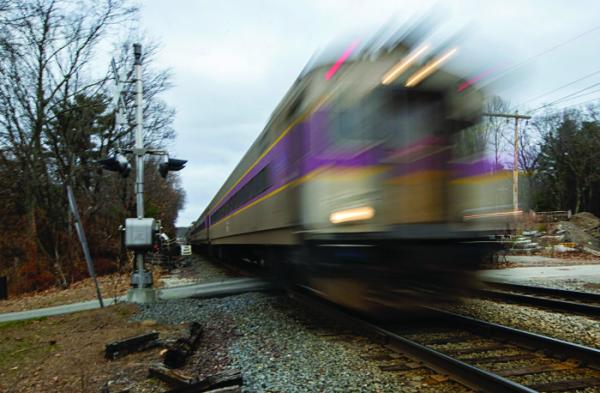May 5, 2022

An MBTA commuter rail train on the Haverhill line travels through Andover.
Jesse Costa/WBUR photo
Weekday ridership on the commuter rail continued to rise in April, to a little more than half of what it was before the pandemic, MBTA data show.
The increase is an encouraging sign that commuter rail service may have turned a corner. Riders are coming back in significant numbers now that pandemic worries are fading.
The higher numbers are driven in part by higher gas prices and workers returning to their offices. That includes people like Patrick Smith of West Roxbury, who works at a non-profit in Fort Point and uses the commuter rail to get there.
“Right now, it’s usually about two to four days a week, just depending on events,” said Smith. “We’re still working with kind of a hybrid schedule, working from home a little bit and then coming into the office.”
The T introduced a new schedule last year aimed at accommodating workers like Smith, who now have more flexibility in when — and how often — they head to the office. Trains are spread through the midday instead of clustered around peak commuting hours, which provides more options throughout the day.
That helps Ray Odlum of Hyde Park get home to rest after working an early shift at a construction site. He gets off at around 1:45 p.m. and catches a 2:45 p.m. train.
“After work and after being up at 3:30 in the morning, I’m ready to go home and go to sleep, man,” he said.
While overall ridership has increased, the demand for monthly commuter rail passes remains well below pre-pandemic levels. The T rolled out a five-day FlexPass in 2020 that offers five one-day passes good for 30 days. The bundle is available on the T’s mTicket app, and offers a 10 percent discount for riders who don’t plan to take the train every day.
The adjustments seem to be helping. According to the T, the agency has sold 53,000 FlexPasses since they were rolled out, generating $4.2 million. Commuter rail ridership swelled after the T introduced the new schedule. It dipped significantly during the winter, as the highly infectious omicron variant spread through the region, but riders returned again as the surge subsided.
Michael Muller, executive director of commuter rail for the MBTA, said he’s not ready to celebrate the rebound, yet — especially with a new subvariant of omicron pushing Covid numbers higher.
“If it weren’t for this subvariant, I think we all felt like we had really turned a corner,” said Muller. “We’re just cautiously optimistic given what’s going on with Covid right now.”
Muller hopes that after the summer, the commuter rail will begin to look more like it did before the coronavirus kept riders away from the system.
“After this latest iteration of Covid is behind us, after summer vacations are behind us, it’ll be interesting to stop and look at where we are then,” he said.
The system is running out of time to regain more riders. The commuter rail accounted for nearly a third of the T’s operating revenue in 2019. Now, the agency anticipates a budget gap projected to reach $236 million before July of 2024.
Transit advocates said the new schedule doesn’t go far enough. Jarred Johnson, executive director of the advocacy group TransitMatters, said the commuter rail needs to run even more frequently: every 7 minutes on some lines and no more than 30 minutes between trains on others.
“If you lower the barriers to using the system, then ridership grows,” said Johnson. “We really need our rail network, our suburban, our regional rail network to be more relevant for more folks and for a wider variety of more trips.”
The T said it’s working toward transforming the system into a regional rail service, which includes more frequent and electrified trains. The new schedule is the first step in that plan.
This segment aired on May 2, 2022. Audio will be available soon.


